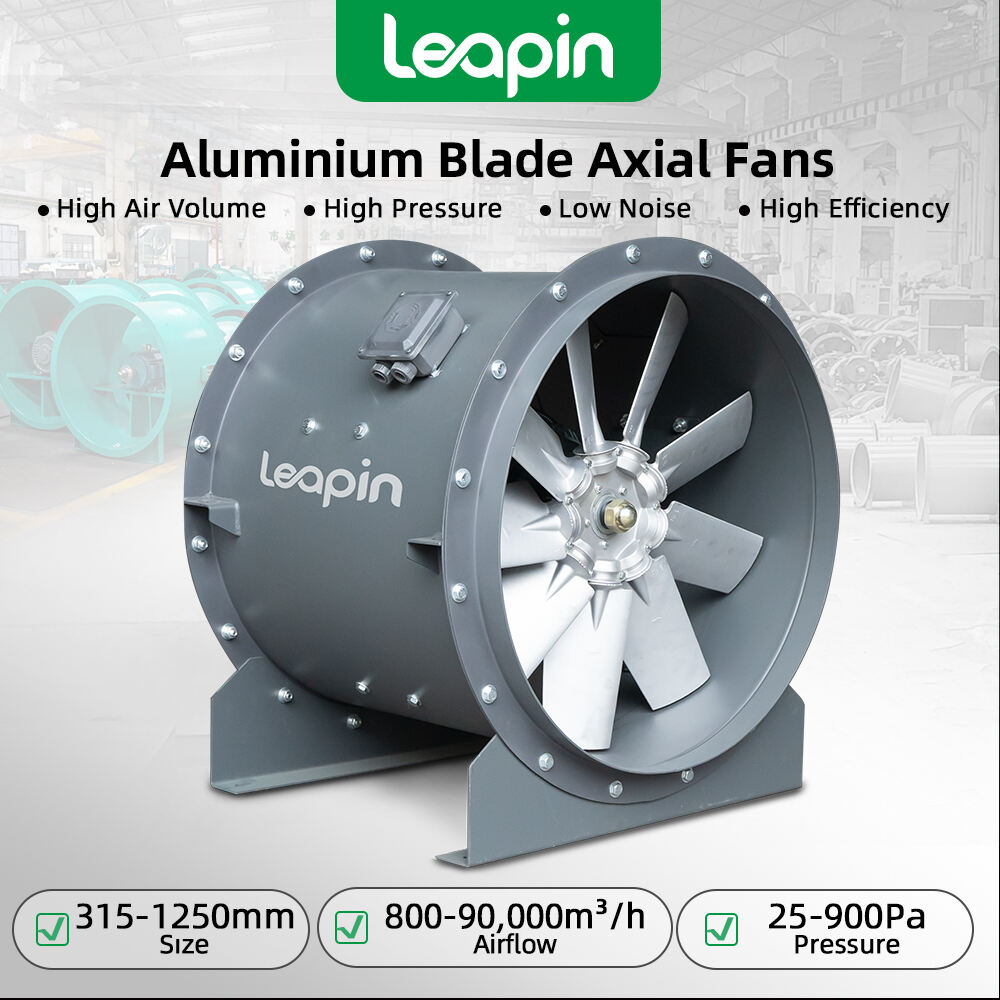The Lowdown on Axial Fans for Industrial and Commercial Use
What Are Axial Fans?
Core Design and Functionality
Axial fans are engineered with a streamlined rotor and blades that enable air to move parallel to the fan's axis, optimizing airflow efficiency. Their design consists of key components, including the rotor, blades, housing, motor, and impellers. These fans generate high-volume, low-pressure air movement; ideal for ventilating expansive spaces such as warehouses and factories. For instance, axial fans are pivotal in industrial settings for ensuring ventilation and cooling, allowing facilities to maintain safe and compliant working environments. Several studies highlight the effectiveness of axial fans; for example, the Insight Partners report noted their popularity in diverse industries for efficient airflow management.
Axial vs. Centrifugal: Key Differences
Axial and centrifugal fans differ fundamentally in their operation; axial fans direct airflow along the fan axis, whereas centrifugal fans move air radially, expelling it at a 90-degree angle. This difference impacts their applications—axial fans excel in scenarios requiring high airflow rates and space efficiency, such as warehouse cooling, while centrifugal fans are suited for handling contaminated air in extreme conditions due to their ability to pressurize and expel air forcefully. Statistics indicate that axial fans offer cost-effective solutions in numerous industrial applications, as evidenced by their widespread use across commercial and industrial environments. In contrast, centrifugal fans are reserved for high-pressure settings, highlighting the distinct advantages axial fans offer in varied applications.
Key Applications in Industrial and Commercial Settings
Ventilation Solutions for Warehouses and Factories
Axial fans play a crucial role in warehouses and factories by enhancing ventilation and improving air quality. These fans efficiently move air across extensive areas, ensuring thorough circulation and optimal temperature control. For instance, the integration of axial fans in warehouse ventilation systems facilitates swift air turnover, maintaining comfortable working conditions and dissipating heat produced by machinery. Industry reports illustrate how well-placed axial fans in factories lead to increased productivity and comfort by minimizing stale air and pollutants. Ultimately, their ability to sustain fresh air flow enhances employee wellness and helps maintain a healthy work environment.
HVAC Systems and Air Exchange
In HVAC systems, axial fans are indispensable for optimizing air exchange and delivering significant energy savings. Their design ensures smooth and consistent air movement, crucial for maintaining ambient temperature and humidity levels in commercial buildings. By effectively circulating air, axial fans help reduce energy consumption, demonstrating improved efficiency and cost savings. The use of axial fans in HVAC systems can lead to substantial reductions in energy use; some studies report energy efficiency improvements of up to 20% when compared to traditional ventilation methods. These savings not only reduce operational costs but also contribute to sustainability efforts within commercial environments.
Fire Safety and Smoke Extraction
Axial fans are vital components in fire safety systems, particularly for smoke extraction in emergencies. Their high-performance design allows for rapid smoke removal, which enhances safety in tall buildings by maintaining clear escape paths and reducing smoke inhalation risks. Systems incorporating axial fans are specifically engineered to quickly expel smoke, maintaining air clarity and improving overall building safety during fires. Compliance with fire safety regulations, such as those set by NFPA, often mandates the use of axial fans for smoke control in commercial structures to ensure effective and reliable performance. This underscores their importance in contemporary fire safety strategies by adhering to and exceeding the standards required for safe building operations.
Advantages of Modern Axial Fan Technology
High Efficiency and Energy Savings
Modern axial fan technology is paving the way for substantial energy savings due to advancements in both blade design and motor technology. Enhanced blade aerodynamics reduce drag and increase efficiency, resulting in significant power consumption reductions. Industry statistics highlight that these improvements can lead to energy savings of up to 30%, directly translating into reduced operational costs for businesses. Consequently, businesses utilizing energy-efficient axial fans can expect lower utility bills and enhanced sustainability efforts, making them an attractive option for companies looking to optimize their environmental impact.
Durable Construction for Harsh Environments
The construction of modern axial fans is tailored to endure harsh industrial conditions, including high temperatures and corrosive environments. Materials like stainless steel and special alloys are used to enhance durability against these challenges. Rigorous testing standards, such as those set by ASME and ASTM, validate these fans' performance and longevity in extreme conditions. Industries such as mining, chemical processing, and oil & gas have successfully implemented these durable axial fans, showcasing their reliability and resilience in demanding settings.
Low Maintenance Requirements
Modern axial fans are equipped with various design features that contribute to their low maintenance requirements, such as self-lubricating bearings. These advancements minimize the need for frequent servicing, leading to increased operational uptime and reduced labor costs. Expert testimonials from facilities managers and engineers affirm the simplicity of maintaining these fans, often citing experiences with significantly decreased maintenance intervals and hassle-free operation. This reduction in maintenance needs ensures businesses can focus on productivity rather than equipment upkeep, thereby enhancing overall efficiency.
Top Axial Fan Models for Industrial Use
ABF Series Axial Fan: Adjustable Aluminum Blades
The ABF Series Axial Fan stands out with its adjustable aluminum blades that allow for customizable airflow. This innovation accommodates diverse industrial requirements by offering flexibility in blade angles and the number of blades. Ideal for industries like civil and industrial sectors, the fan's design provides efficient ventilation and air exchange, a crucial feature validated by precise testing instruments. Moreover, it meets high standards of performance with its reliable craftsmanship, making it a preferred choice among industrial settings. For more information on this model, check out the ABF Series Axial Fan.
HTF-T Series: Fire-Rated Smoke Extraction
The HTF-T Series axial fan is engineered for fire-rated smoke extraction, offering unparalleled safety in emergencies. Its specifications emphasize high efficiency and low noise, making it suitable for rigorous fire safety applications in civil buildings, tunnels, and more. It complies with stringent fire safety standards, ensuring its reliability when needed most. This series has been successfully utilized in real-world installations, confirming its capability to handle the demanding requirements of fire smoke exhaust systems. Explore more about the HTF-T Axial Fan series.
Aluminium Blade ABF Series: Corrosion-Resistant Design
The Aluminium Blade ABF Series axial fan boasts a corrosion-resistant design, making it ideal for harsh industrial environments. Its components are coated to resist deterioration, enhancing durability. The fan's longevity is supported by tests and reviews, confirming its reliability across various applications. Choosing these corrosion-resistant fans can be economically beneficial as they ensure operational efficiency and reduce the need for frequent replacements. To delve deeper into these advantages, visit the Aluminium Blade Axial Fans ABF Series.
Choosing the Right Axial Fan for Your Needs
Evaluating Airflow and Pressure Requirements
When choosing an axial fan, evaluating the specific airflow and pressure requirements of your application is crucial. Accurate assessment ensures that the fan operates efficiently and meets your needs. Determining the required airflow involves identifying the volume of air that needs to be circulated, which can vary significantly depending on the type of process or environment. Similarly, understanding pressure requirements is vital to ensure that the fan can overcome system resistance and deliver optimal performance. Tools like fan curve charts and software can assist in these calculations by matching fan specifications to your application needs. These evaluations form the foundation for selecting the right industrial fan that maximizes performance and energy efficiency.
Environmental Factors: Temperature and Hazard Ratings
Environmental factors, such as temperature and hazard ratings, significantly impact how axial fans are chosen and used in industrial settings. Temperature can affect the material and design choices for fans, with high-temperature environments requiring fans capable of sustaining performance without degradation. In terms of hazards, understanding industry standards like ATEX ratings for explosive atmospheres helps in selecting fans that ensure safety in environments with potential risks. A careful review of these environmental conditions not only enhances operational efficiency but also ensures safety compliance, minimizing the risk of accidents and maintaining uninterrupted production. By considering these factors, one can make informed decisions that align with industry standards, marrying performance with compliance.

 EN
EN
 AR
AR
 FR
FR
 RU
RU
 ES
ES
 TL
TL
 ID
ID
 VI
VI
 TH
TH
 MS
MS
 BN
BN




